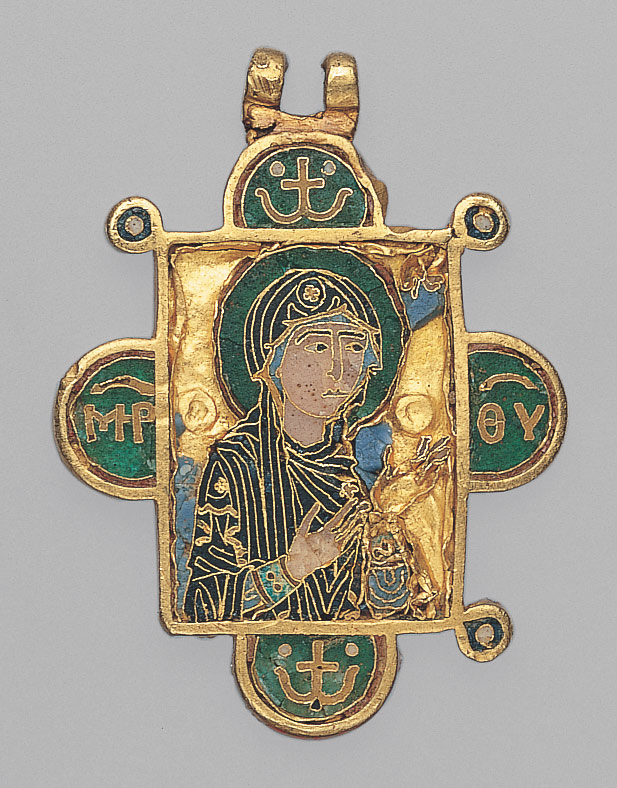
Virgin Mary, pendant, Constantinople, ca. 1100, gold, enamel
As much as is known about the public practice of the Christian religion over the centuries, the knowledge about devotion and encounters with God in private spaces remains hidden. But there are clues and, above all, artifacts that shed some light on the culture of private religious life. Some treasures made of wood or lace, In earlier times, things made of silk or cotton, made of sheet metal or glass have been preserved through the centuries and still exude a great aura. In the Middle Ages, Christians strengthened their faith in public rituals, such as the worship service and the communal celebration of the Eucharist in the newly built or carefully maintained churches. But believers also created private meeting areas with the heavenly powers in private chapels, a monk's cell or a corner of their own house. To this day, the Herrgottswinkel has been preserved in many houses, especially in the Alpine region. It is much more than a protective symbol, it is a place of refuge, of worship, of the sacred in the middle of everyday life. According to an article from the Metropolitan Museum of Art, New York, there were also zones for people in the Middle Ages, where they sought to deepen their faith. Places of peace and meditation, prayer and dialogue with God. Psalters or private prayer books written by hand by monks appeared.
Pictures that were mostly small in size helped with the mental exercises. They provided a tangible object, gave outline to the subject of worship, and aided in concentration. In the Middle Ages, such images were produced in all sorts of materials, depending on the wealth and rank of the owner: “from parchment to gold, from ivory to clay.” Stories, mostly from the New Testament, from the life and passion of Jesus Christ, were painted on it or carved into the surface. But the material and the execution were not the reason for the intimate treatment of these objects, which people sometimes carried close to their bodies all the time, which accompanied them throughout their lives, which they repeatedly kissed and touched tenderly, especially when they were faced with difficult tasks or had to overcome crises. Sometimes these devotional objects even contained the relics of a saint. Traces of worship can be seen in most surviving artifacts, so much so that some carvings are barely recognizable.
In a certain way, the images assured believers of the presence of those depicted in them in the here and now. This is an original function of devotional pictures and that, like all devotional objects, makes them so unique. This is probably why they are extremely rarely the subject of art historical consideration.
The devotional pictures were often said to have a special power to experience the closeness of God. I don't know whether this power was considered transferable to another person, such as an heir. There may have been one or two devotional items that were passed down through generations in a family. I'm not talking about relics whose power can be transferred, but rather about these small, personal, often touchingly naive devotional images whose owners are convinced that they are a little more connected to God. Even if it is not part of the faith in Christian terms and should be viewed more critically, Many people believed they were getting closer to God through these objects. In Christianity, man-made things themselves are generally not assigned any powers, which is why there are no Christian amulets or “good luck charms”. Fortunately, at least the Catholic Church never really stopped this kind of popular piety and private devotional culture. Bringing God – in whatever form – into everyday life cannot be un-Christian. If artistic things are exalted by the realm of the sacred, and so much so, The fact that ultimately only this exalted meaning is important to the individual is a sign of the finest cultivation. But I will research it further and report here.
Quelle: Department of Medieval Art and The Cloisters. “Private Devotion in Medieval Christianity.” In Heilbrunn Timeline of Art History. New York: The Metropolitan Museum of Art, 2000–. http://www.metmuseum.org/toah/hd/priv/hd_priv.htm (October 2001)



